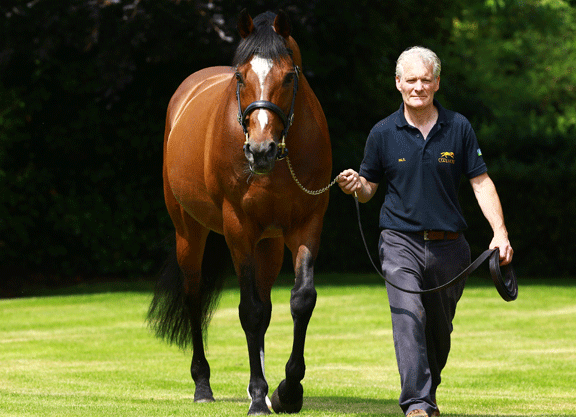By John Boyce
It's 50 years since the great Vincent O'Brien first laid eyes on the imperious Nijinsky II on a yearling inspection trip to America, thus altering for evermore the course of Thoroughbred breeding in Europe. Of course, Nijinsky drew O'Brien's attention to the not inconsiderable merits of Northern Dancer, a stallion that still sets the standard when it comes producing elite racehorses. And Coolmore is still reaping the benefits today, through Northern Dancer's son Sadler's Wells and his son Galileo (Ire). Never has there been a more prolific father-son-grandson combination in the history of the breed. And very soon it looks like the grandson will overtake his sire to become number one among the trio when assessed by individual Group 1 winners. Currently on 72, Galileo needs just one more winner at the top level to equal Sadler's Wells. Barring a complete change of fortune, it must also be on the cards that he will also overhaul Danehill's tally of 84 Group 1 winners, compiled with the help of covering for many years in both hemispheres.
But how are we to assess Galileo in the context of his father's achievements? Veterinary science, for all its many benefits, has made that take a good deal harder. Sadler's Wells's book sizes were considered large at the time, particularly in the light of what went before. But now even his numbers are dwarfed by modern day standards. A good starting point for comparison is to assess which stallion has produced the best racehorses, regardless of the qualitative or quantitative opportunity each has received. On this score, Galileo's top 10 Timeform-rated runners have averaged 132.3 compared to his sire's 131.4. Of course, Galileo is responsible for the 147-rated Frankel, who is a full 10 pounds ahead of Sadler's Wells's best offspring Montjeu (Ire). It's hard to imagine that there was ever a horse that could give so much weight to Montjeu at his very best. It's conceivable that Galileo will also improve in his best 10 score–his sons and daughters have to achieve a rating of 130 or higher to break into their sire's top 10 as Ulysses (Ire) did recently. It's also significant, notwithstanding the bigger books enjoyed by Galileo, that he's achieved what he has much sooner than his sire. But, just to put things in context, Northern Dancer with only one-third the number of foals of Galileo achieved a top 10 average Timeform score of 133.3, and some of his best didn't even run in Europe.
Looking at the pair using the ratio and quality of their stakes winners the balance is also tipped in favour of Galileo. Sadler's Wells does have a marginally superior percentage of stakes winners (17.8%) compare to Galileo's 16.4%, but the average Timeform rating of Sadler's Wells's 294 stakes winners is a full pound behind those by Galileo, which given the numbers involved is pretty significant. Moreover, Galileo gets 11% group winners to runners, compared to his dad's 10.2%. We also know that smaller books for Sadler's Wells also meant more select mares. So, if we look at the percentage of stakes winners again, this time only considering elite mares, Galileo sires 27% stakes winners and his father 25%.
Regarding aptitude, the typical Sadler's Wells was a middle-distance horse or even a Cup horse like Kayf Tara (GB). Galileo, on the other hand, has a lower stamina index from quicker mares. He has already sired 86 stakes winners at a mile or less, compared to his father's 63. And he's up to 27 Group 1 winners at a mile or less, six ahead of his sire. Galileo's sharper runners are typified by his two highest-rated runners–Frankel (GB) and Rip Van Winkle (Ire)–who both were top-class at a mile, even though they stayed further. Galileo has eight Group 1-winning juveniles at up to seven furlongs while Sadler's Wells managed six, including two–Scenic (Ire) and Prince Of Dance (Ire)–who dead-heated in the Dewhurst. And Galileo's Clemmie (Ire), winner of the Cheveley Park S. last year, is the only Group 1 winner over six furlongs for the pair.
What really unites these two super sires is their ability to upgrade their mares–no easy feat when they are already covering the very best around. When other sires were bred to Sadler's Wells's mares, 11.9% of their offspring were rated 115-plus by Timeform, yet the great son of Northern Dancer managed 13.6%. It's the same story with Galileo–he sires 12.9% horses rated 115-plus by Timeform from mares that normally manage 10.5%.
It is perhaps too soon to evaluate Galileo as a sire of sires or sire of broodmares. He's already got a trio of very competent sire sons in Frankel, Teofilo (Ire) and New Approach (Ire) and no fewer than six–also including the up-and-coming Nathaniel (Ire), Intello (Ger) and Australia (GB)–have sired Northern Hemisphere group winners this year. He has 14 Group 1 winners as a broodmare sire. Sadler's Wells, meanwhile, has Galileo, Montjeu and In The Wings (GB) as three sire sons that managed 10%-plus stakes winners to runners. He's up to 61 Group 1 winners as a broodmare sire. It's easy to see why these two magnificent thoroughbreds have underpinned the Coolmore operation for so long.
Not a subscriber? Click here to sign up for the daily PDF or alerts.






